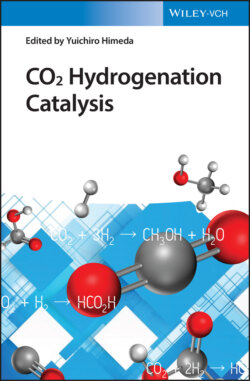Читать книгу CO2 Hydrogenation Catalysis - Группа авторов - Страница 23
References
Оглавление1 1 IEA. (2019). Global energy & CO2 status report 2019. The latest trends in energy and emissions in 2018. https://www.iea.org/reports/global-energy-co2-status-report-2019/emissions#abstract (accessed 8 September 2020).
2 2 National Oceanic and Atmospheric Administration. Global Monitoring Laboratory. https://www.esrl.noaa.gov/gmd/ccgg/trends/data.html (accessed 5 June 2020).
3 3 Kristin Onarheim, Antti Arasto (2017). Market‐driven future potential of Bio‐CC(U)S, http://task41project5.ieabioenergy.com/publications/market-driven-future-potential-bio-ccus/ (accessed 5 June 2020).
4 4 Rogelj, J., Huppmann, D., Krey, V. et al. (2019). Nature 573 (7774): 357–363.
5 5 IEA. (2019) Putting CO2 to use – Creating value from emissions. https://www.iea.org/reports/putting-co2-to-use (accessed 8 September 2020).
6 6 Omae, I. (2012). Coord. Chem. Rev. 256 (13): 1384–1405.
7 7 Short‐Term Fertilizer Outlook 2019–2020. (2019). https://www.ifastat.org/market-outlooks (accessed 16 June 2020).
8 8 Fukuoka, S., Fukawa, I., Adachi, T. et al. (2019). Org. Process Res. Dev. 23 (2): 145–169.
9 9 Carbon Recycling International. https://www.carbonrecycling.is/ (accessed 17 June 2020).
10 10 2018–2023 Global Formic Acid Consumption Market Report. (2018). https://www.marketinsightsreports.com/reports/1120988312/2018-2023-global-formic-acid-consumption-market-report (accessed 12 June 2020).
11 11 Hietala, J., Vuori, A., Johnsson, P. et al. (2016). Formic Acid. In: Ullmann's Encyclopedia of Industrial Chemistry, 1–22. Wiley‐VCH.
12 12 Perez‐Fortes, M., Schoneberger, J.C., Boulamanti, A. et al. (2016). Int. J. Hydrogen Energy 41 (37): 16444–16462.
13 13 Sordakis, K., Tang, C.H., Vogt, L.K. et al. (2018). Chem. Rev. 118 (2): 372–433.
14 14 Wang, W.‐H., Himeda, Y., Muckerman, J.T. et al. (2015). Chem. Rev. 115 (23): 12936–12973.
15 15 Müller, K., Brooks, K., and Autrey, T. (2018). Energy Fuels 32 (9): 10008–10015.
16 16 Global methanol demand (Methanol Institute). https://www.methanol.org/methanol-price-supply-demand/ (accessed 15 June 2020).
17 17 Dalena, F., Senatore, A., Marino, A. et al. (2018). Chapter 1. Methanol production and applications: an overview. In: Methanol (eds. A. Basile and F. Dalena), 3–28. Elsevier.
18 18 DECHEMA. (2017). Low carbon energy and feedstock for the European chemical industry. https://dechema.de/Low_carbon_chemical_industry.html (accessed 8 September 2020).
19 19 Chang, C.D. and Silvestri, A.J. (1977). J. Catal. 47 (2): 249–259.
20 20 Production capacity, production and demand on petrochemical products. (2019). Ministry of Economy, Trade and Industry of Japan. https://www.meti.go.jp/policy/mono_info_service/mono/chemistry/downloadfiles/04_2019syouhinbetudeta.pdf (accessed 16 June 2020).
21 21 Market Analytics: Methanol and Derivatives (2019). https://www.nexantsubscriptions.com/reports/market-analytics-methanol-and-derivatives-2019 (accessed 13 June 2020).
22 22 Olah, G.A. (2005). Angew. Chem. Int. Ed. 44 (18): 2636–2639.
23 23 Asinger, F. (1986). Methanol—Chemie‐ und Eneigierohstoff. Berlin Heidelberg: Springer‐Verlag.
24 24 Olah, G.A., Goeppert, A., and Prakash, G.K.S. (2018). Beyond Oil and Gas: The Methanol Economy, 3e. Wiley‐VCH.
25 25 Bailera, M., Lisbona, P., Romeo, L.M. et al. (2017). Renewable Sustainable Energy Rev. 69: 292–312.
26 26 The first industrial PtG plant–Audi e‐gas as driver for the energy turnaround. (2014). http://www.cedec.com/files/default/8-2014-05-27-cedec-gas-day-reinhard-otten-audi-ag.pdf (accessed 10 June 2020).
27 27 Jarvis, S.M. and Samsatli, S. (2018). Renewable Sustainable Energy Rev. 85: 46–68.
28 28 Capturing and Utilizing CO2 from Ethanol: Adding Economic Value and Jobs to Rural Economies and Communities While Reducing Emissions (2017). http://www.kgs.ku.edu/PRS/ICKan/2018/March/WhitePaper_EthanolCO2Capture_Dec2017_Final2.pdf (accessed 10 June 2020).
29 29 Greenhouse Gas Inventory Data. https://di.unfccc.int/detailed_data_by_party (accessed 12 June 2020).
30 30 Xu, Y., Isom, L., and Hanna, M.A. (2010). Bioresour. Technol. 101 (10): 3311–3319.
31 31 Bosoaga, A., Masek, O., and Oakey, J.E. (2009). Energy Proc. 1 (1): 133–140.
32 32 CO2 Emissions from Fuel Combustion (2019). https://www.iea.org/subscribe-to-data-services/co2-emissions-statistics (accessed 12 June 2020).
33 33 Styring, P. (2015). Carbon dioxide capture agents and processes (Chapter 2). In: Carbon Dioxide Utilisation: Closing the Carbon Cycle (eds. P. Styring, E.A. Quadrelli and K. Armstrong), 19–32. Elsevier.
34 34 Shell Cansolv Deploying CCS Worldwide. (2013). https://ieaghg.org/docs/General_Docs/PCCC2/Secured%20pdfs/3_PCCC2-Just-September2013.pdf (accessed 16 June 2020).
35 35 Survey on the Carbon Capture and Storage process (2017). Center for Low Carbon Society Strategy, Japan Science and Technology Agency. https://www.jst.go.jp/lcs/pdf/fy2016-pp-06.pdf (accessed 16 June 2020).
36 36 Sanz‐Perez, E.S., Murdock, C.R., Didas, S.A. et al. (2016). Chem. Rev. 116 (19): 11840–11876.
37 37 Direct Air Capture (2020). https://www.iea.org/reports/direct-air-capture (accessed 18 September 2020).
38 38 Explore energy data by category, indicator, country or region (IEA). https://www.iea.org/data-and-statistics?country=WORLD&fuel=Energy%20supply&indicator=Low-carbon%20electricity%20generation%20by%20source (accessed 13 June 2020).
39 39 Lazard's Levelized Cost of Energy Analysis (2018). https://www.lazard.com/media/450784/lazards-levelized-cost-of-energy-version-120-vfinal.pdf (accessed 12 June 2020).
40 40 Alvarez, A., Bansode, A., Urakawa, A. et al. (2017). Chem. Rev. 117 (14): 9804–9838.
41 41 IEA. (2019). The Future of Hydrogen – Seizing today’s opportunities. https://www.iea.org/reports/the-future-of-hydrogen (accessed 7 September 2020).
42 42 Status of carbon taxes in various countries (2017). https://www.env.go.jp/policy/tax/misc_jokyo/attach/intro_situation.pdf (accessed 12 June 2020).
